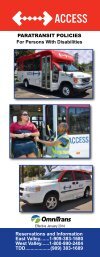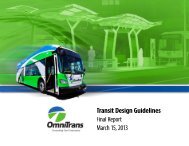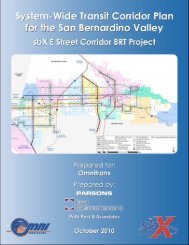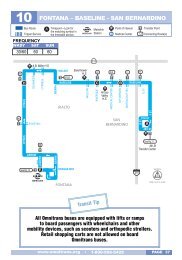Short Range Transit Plan 2008-2013 - Omnitrans
Short Range Transit Plan 2008-2013 - Omnitrans
Short Range Transit Plan 2008-2013 - Omnitrans
Create successful ePaper yourself
Turn your PDF publications into a flip-book with our unique Google optimized e-Paper software.
IBI GROUP<br />
SHORT RANGE TRANSIT PLAN REPORT<br />
OMNITRANS COMPREHENSIVE OPERATIONAL ASSESSMENT<br />
& SHORT RANGE TRANSIT PLAN<br />
West Valleys. The market and line segment analysis and the stakeholder surveys have identified the<br />
strengths and weaknesses in the transit system and the needs that should be met.<br />
Market Penetration – Ridership on the <strong>Omnitrans</strong> routes consists of 25% students attending the<br />
universities, colleges and high schools in the service area, 64% adults using the routes for work purposes<br />
(44%) and for shopping, social, and other purposes (20%), and 11% seniors using the routes primarily for<br />
shopping, social, medical and other purposes. Students, seniors, and adults with limited car access are<br />
transit’s main markets.<br />
• 4,600 students (12-24 years of age) use the transit system on school days, which<br />
is about 4% of the students enrolled in the high schools, colleges and universities<br />
in the service area. This represents 14,000 unlinked weekday passenger trips or<br />
25% of the daily ridership. When compared to the peer systems with colleges<br />
and universities, student ridership could be higher, suggesting that this market<br />
could be better served by the transit system, particularly the college market.<br />
• 16,000 adults (25 to 65 years of age) use the transit system on weekdays, which<br />
is about 5% of the adult population with limited access to an automobile and<br />
comparable to most other transit properties. This represents 39,500 unlinked<br />
weekday passenger trips or 64% of the daily ridership. Considering that 85% of<br />
the ridership is captive to transit, it is clear that <strong>Omnitrans</strong> needs to improve its<br />
services to attract more choice riders, particularly workers commuting to<br />
destinations outside the County.<br />
• 32% of all work trips are made to destinations outside the County, primarily to<br />
Los Angeles County (17%), Riverside County (8%), and Orange County (4%).<br />
This represents about 400,000 daily trips as compared to an estimated 3,000<br />
daily passenger trips carried on the transit system to/from the Transcenters<br />
connecting with Metrolink and Foothill <strong>Transit</strong> services, and to/from Riverside on<br />
Route 90. This is a small market share with significant potential for improvement.<br />
• 1,400 seniors use the fixed routes on weekdays, which is 6% of <strong>Omnitrans</strong> fixed<br />
route ridership and consistent with the market share experienced by most of<br />
<strong>Omnitrans</strong>’ peer systems with fixed route and dial-a-ride services.<br />
Market Demands – It is clear that transit needs to keep pace with the changing and growing demands of<br />
the student and adult markets in order to grow the ridership base cost-effectively. Currently, there are<br />
several deficiencies that are creating unmet demands in the transit markets. <strong>Omnitrans</strong> will not be able to<br />
meet the long-term growth and development goals of the County without addressing the unmet needs of<br />
these markets. The main needs are related to deficiencies in the structures, frequencies and spans of the<br />
routes. Firstly, 60-minute service and 12-hour spans are not appropriate for an urban transit system<br />
serving students and adult commuters; the Route 7, 8, 9, 10, 28, 29, 60, 67, 70, 71 and 75 service areas<br />
are affected by this serious deficiency. Secondly, the structure of several routes need to be changed and<br />
extended to better serve the student and adult markets; Routes 8, 9, 14, 15, 29, 60, 62, 66, 68, 70, and<br />
71 are in this category. In total, there is an estimated unmet demand of 12,000 daily passenger trips.<br />
Service Performance – In order to be cost-effective, transit needs to provide services that can operate<br />
on-time and can carry at least 20 passengers per hour Monday to Saturday and 10 passengers per hour<br />
on Sundays and holidays. Routes 8, 11, 28, 31, 60, 67, 68, 70, 75 and 90 do not meet these standards<br />
and need to be restructured or dropped to reduce revenue hours and costs. In total, the services on<br />
these routes need to be reduced by an estimated 200 daily revenue hours, which will affect some 1,500<br />
daily passenger trips.<br />
July 11, 2007 183














